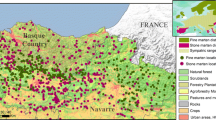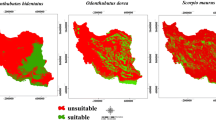Abstract
Context
Carnivores in the central Iranian plateau have experienced considerable declines in their populations during the last century. Ecological niche models can inform conservation efforts aimed at increasing the suitability of carnivore habitat by providing valuable information on the scale-dependent relationships between species and their environment.
Objectives
We used a multiscale modeling framework to predict habitat suitability and investigate the influence of spatial scale on species-environment relationships for three sympatric felids, chosen as surrogate species, including Asiatic cheetah (Acynonix jubatus), Persian leopard (Panthera pardus), and sand cat (Felis margarita) with the aim of informing conservation efforts for these species and other Iranian carnivores more widely.
Methods
We used opportunistically collected occurrence data and a presence-only, multiscale MaxEnt approach whilst exploring the impact of spatial filtering and data partitioning on model predictions and performance.
Results
Scaling optimization showed that the performance of models was associated with variables at multiple spatial scales, with relationships tending to be strongest at the largest scales (4–8 km). Our findings showed that landscape composition generally have stronger influences on occurrence of the studied species than configuration. The comparison among models showed distinct patterns of habitat selection, implying niche partitioning between species.
Conclusions
Our knowledge of scale-dependent relationships between three sympatric felids and their spatial niches facilitates effective conservation of habitat connectivity for multiple carnivore species by prioritizing predicted key suitable patches inside and outside of protected areas which have significant contribution in maintaining landscape connectivity in Iran.






Similar content being viewed by others
References
Ahmadi M, Nezami Balouchi B, Jowkar H, Hemami MR, Fadakar D, Malakouti-Khah S, Ostrowski S (2017) Combining landscape suitability and habitat connectivity to conserve the last surviving population of cheetah in Asia. Divers Distrib 23(6):592–603
Barbet-Massin M, Jiguet F, Albert CH, Thuiller W (2012) Selecting pseudo-absences for species distribution models: how, where and how many? Methods Ecol Evol 3(2):327–338
Bellamy C, Scott C, Altringham J (2013) Multiscale, presence-only habitat suitability models: fine-resolution maps for eight bat species. J Appl Ecol 50(4):892–901
Bellamy CC, van der Jagt AP, Barbour S, Smith M, Moseley D (2017) A spatial framework for targeting urban planning for pollinators and people with local stakeholders: a route to healthy, blossoming communities? Environ Res 158:255–268
Boria RA, Olson LE, Goodman SM, Anderson RP (2014) Spatial filtering to reduce sampling bias can improve the performance of ecological niche models. Ecol Model 275:73–77
Bowman A, Azzalini A (2015) package ‘sm’: nonparametric smoothing methods (version 2.2-5.4). 2014
Brown JL (2014) SDMtoolbox: a python-based GIS toolkit for landscape genetic, biogeographic and species distribution model analyses. Methods Ecol Evol 5(7):694–700
Caro T (2010) Conservation by proxy: indicator, umbrella, keystone, flagship, and other surrogate species. Island Press
Coetzee BW (2017) Evaluating the ecological performance of protected areas. Biodivers Conserv 26(1):231–236
Cohen J (1960) A coefficient of agreement for nominal scales. Educ Psychol Measur 20(1):37–46
Cohen J (1968) Weighted kappa: nominal scale agreement provision for scaled disagreement or partial credit. Psychol Bull 70(4):213
Cushman SA, Elliot NB, Bauer D, Kesch K, Bothwell H, Flyman M, Mtare G, Macdonald DW, Loveridge AJ (2018) Prioritizing core areas, corridors and conflict hotspots for lion conservation in southern Africa. PloS one 13(7):e0196213
Di Minin E, Hunter LT, Balme GA, Smith RJ, Goodman PS, Slotow R (2013) Creating larger and better connected protected areas enhances the persistence of big game species in the Maputaland-Pondoland-Albany biodiversity hotspot. PLoS ONE 8(8):e71788
Dröge E, Creel S, Becker MS, M’soka J (2017) Spatial and temporal avoidance of risk within a large carnivore guild. Ecol Evol 7(1):189–199
Durant SM, Craft ME, Foley C, Hampson K, Lobora AL, Msuha M, Eblate E, Bukombe J, Mchetto J, Pettorelli N (2010) Does size matter? An investigation of habitat use across a carnivore assemblage in the Serengeti, Tanzania. J Anim Ecol 79(5):1012–1022
Evans J, Oakleaf J, Cushman S, Theobald D (2014) An ArcGIS toolbox for surface gradient and geomorphometric modeling, version 2.0-0. Laramie, WY. http://evansmurphy.wix.com/evansspatial
Fahrig L (2003) Effects of habitat fragmentation on biodiversity. Annu Rev Ecol Evol Syst 34(1):487–515
Farhadinia MS, Ahmadi M, Sharbafi E, Khosravi S, Alinezhad H, Macdonald DW (2015) Leveraging trans-boundary conservation partnerships: persistence of Persian leopard (Panthera pardus saxicolor) in the Iranian Caucasus. Biol Conserv 191:770–778
Farhadinia M, Hemami M-R (2010) Prey selection by the critically endangered Asiatic cheetah in central Iran. J Nat Hist 44(19–20):1239–1249
Flather CH, Bevers M (2002) Patchy reaction-diffusion and population abundance: the relative importance of habitat amount and arrangement. Am Nat 159(1):40–56
Flint LE, Flint AL (2012) Downscaling future climate scenarios to fine scales for hydrologic and ecological modeling and analysis. Ecol Process 1(1):2
Fourcade Y, Engler JO, Rödder D, Secondi J (2014) Mapping species distributions with MAXENT using a geographically biased sample of presence data: a performance assessment of methods for correcting sampling bias. PLoS ONE 9(5):e97122
Gábor L, Moudrý V, Barták V, Lecours V (2019) How do species and data characteristics affect species distribution models and when to use environmental filtering? Int J Geogr Inf Sci. https://doi.org/10.1080/13658816.2019.1615070
Hayward M, Henschel P, O’brien J, Hofmeyr M, Balme G, Kerley G (2006) Prey preferences of the leopard (Panthera pardus). J Zool 270(2):298–313
Hearn AJ, Cushman SA, Ross J, Goossens B, Hunter LT, Macdonald DW (2018) Spatio-temporal ecology of sympatric felids on Borneo. Evidence for resource partitioning? PloS ONE 13(7):e0200828
Hemami M-R, Esmaeili S, Brito JC, Ahmadi M, Omidi M, Martínez-Freiría F (2018) Using ecological models to explore niche partitioning within a guild of desert felids. Hystrix Ital J Mammal 29(2):216–222
Hemami M, Groves C (2001) Global antelope survey and regional action plans: Iran. In: Mallon D, Kingswood S (eds) Antelopes: Part 4 North Africa. The Middle East and Asia. Switzerland and Cambridge: IUCN, pp 114–118
Hijmans RJ, Cameron SE, Parra JL, Jones PG, Jarvis A (2005) Very high resolution interpolated climate surfaces for global land areas. Int J Climatol 25(15):1965–1978
Hijmans RJ, Phillips S, Leathwick J, Elith J, Hijmans MRJ (2016) Package ‘dismo’. Circles, 1
Holland JD, Bert DG, Fahrig L (2004) Determining the spatial scale of species’ response to habitat. AIBS Bull 54(3):227–233
Huang Q, Fleming CH, Robb B, Lothspeich A, Songer M (2018) How different are species distribution model predictions?—Application of a new measure of dissimilarity and level of significance to giant panda Ailuropoda melanoleuca. Ecol Inform 46:114–124
Jueterbock A (2015) ‘MaxentVariableSelection’vignette
Khalatbari L, Yusefi GH, Martínez-Freiría F, Jowkar H, Brito JC (2018) Availability of prey and natural habitats are related with temporal dynamics in range and habitat suitability for Asiatic Cheetah. Hystrix Ital J Mammal 29(1):145–151
Khosravi R, Hemami M-R (2019) Identifying landscape species for ecological planning. Ecol Ind 99:140–148
Khosravi R, Hemami MR, Cushman SA (2018) Multispecies assessment of core areas and connectivity of desert carnivores in central Iran. Divers Distrib 24(2):193–207
Khosravi R, Hemami MR, Malekian M, Flint A, Flint L (2016) Maxent modeling for predicting potential distribution of goitered gazelle in central Iran: the effect of extent and grain size on performance of the model. Turk J Zool 40(4):574–585
Kittle AM, Watson AC, Cushman SA, Macdonald DW (2018) Forest cover and level of protection influence the island-wide distribution of an apex carnivore and umbrella species, the Sri Lankan leopard (Panthera pardus kotiya). Biodivers Conserv 27(1):235–263
Kramer-Schadt S, Niedballa J, Pilgrim JD, Schröder B, Lindenborn J, Reinfelder V, Stillfried M, Heckmann I, Scharf AK, Augeri DM (2013) The importance of correcting for sampling bias in MaxEnt species distribution models. Divers Distrib 19(11):1366–1379
Liu C, White M, Newell G (2013) Selecting thresholds for the prediction of species occurrence with presence-only data. J Biogeogr 40(4):778–789
Mateo Sanchez MC, Cushman SA, Saura S (2013) Scale dependence in habitat selection: the case of the endangered brown bear (Ursus arctos) in the Cantabrian Range (NW Spain). Int J Geogr Inf Sci 28(8):1531–1546
McGarigal K, Cushman S, Ene E (2012) FRAGSTATS v4: spatial pattern analysis program for categorical and continuous maps. University of Massachusetts, Amherst, Massachusetts, USA. www.goo.gl/aAEbMk
McGarigal K, Wan HY, Zeller KA, Timm BC, Cushman SA (2016a) Multi-scale habitat selection modeling: a review and outlook. Landscape Ecol 31(6):1161–1175
McGarigal K, Zeller KA, Cushman SA (2016b) Multi-scale habitat selection modeling: introduction to the special issue. Landscape Ecol 31(6):1157–1160
Phillips SJ, Anderson RP, Schapire RE (2006) Maximum entropy modeling of species geographic distributions. Ecol Model 190(3–4):231–259
Rabinowitz A, Zeller KA (2010) A range-wide model of landscape connectivity and conservation for the jaguar, Panthera onca. Biol Conserv 143(4):939–945
Radosavljevic A, Anderson RP (2014) Making better Maxent models of species distributions: complexity, overfitting and evaluation. J Biogeogr 41(4):629–643
Redding DW, Lucas TC, Blackburn TM, Jones KE (2017) Evaluating Bayesian spatial methods for modelling species distributions with clumped and restricted occurrence data. PLoS ONE 12(11):e0187602
Reddy PA, Cushman SA, Srivastava A, Sarkar MS, Shivaji S (2017) Tiger abundance and gene flow in Central India are driven by disparate combinations of topography and land cover. Divers Distrib 23(8):863–874
Sauder JD, Rachlow JL (2014) Both forest composition and configuration influence landscape-scale habitat selection by fishers (Pekania pennanti) in mixed coniferous forests of the Northern Rocky Mountains. For Ecol Manage 314:75–84
Shahnaseri G, Hemami M-R, Khosravi R, Malakoutikhah S, Omidi M, Cushman SA (2019) Contrasting use of habitat, landscape elements, and corridors by grey wolf and golden jackal in central Iran. Landscape Ecol 34:1263–1277
Shirk AJ, Raphael MG, Cushman SA (2014) Spatiotemporal variation in resource selection: insights from the American marten (Martes americana). Ecol Appl 24(6):1434–1444
Shirk AJ, Wasserman TN, Cushman SA, Raphael MG (2012) Scale dependency of American marten (Martes americana) habitat relations [Chapter 12]. In: Aubry KB, Zielinski WJ, Raphael MG, Proulx G, Buskirk SW (eds) Biology and conservation of martens, sables, and fishers: a new synthesis. Cornell University Press, Ithaca, pp 269–283
Syfert MM, Smith MJ, Coomes DA (2013) The effects of sampling bias and model complexity on the predictive performance of MaxEnt species distribution models. PLoS ONE 8(2):e55158
Vergara M, Cushman SA, Urra F, Ruiz-González A (2016) Shaken but not stirred: multiscale habitat suitability modeling of sympatric marten species (Martes martes and Martes foina) in the northern Iberian Peninsula. Landscape Ecol 31(6):1241–1260
Villard MA, Metzger JP (2014) Beyond the fragmentation debate: a conceptual model to predict when habitat configuration really matters. J Appl Ecol 51(2):309–318
Wan JZ, Wang CJ, Tan JF, Yu FH (2017) Climatic niche divergence and habitat suitability of eight alien invasive weeds in China under climate change. Ecol Evol 7(5):1541–1552
Warren DL, Glor RE, Turelli M (2010) ENMTools: a toolbox for comparative studies of environmental niche models. Ecography 33(3):607–611
Wasserman TN, Cushman SA, Wallin DO (2012) Multi scale habitat relationships of Martes americana in northern Idaho, USA. U.S. Department of Agriculture, Forest Service, Rocky Mountain Research Station, Fort Collins, p 21
Acknowledgements
We are grateful to Isfahan and Yazd provincial DOE for permission to enter to PAs. Also, we are extremely grateful for the support from the Isfahan University of Technology. This research was financially supported by a postdoctoral scholarship from the Iran's National Elites Foundation.
Author information
Authors and Affiliations
Corresponding author
Additional information
Publisher's Note
Springer Nature remains neutral with regard to jurisdictional claims in published maps and institutional affiliations.
Electronic supplementary material
Below is the link to the electronic supplementary material.
Rights and permissions
About this article
Cite this article
Khosravi, R., Hemami, MR. & Cushman, S.A. Multi-scale niche modeling of three sympatric felids of conservation importance in central Iran. Landscape Ecol 34, 2451–2467 (2019). https://doi.org/10.1007/s10980-019-00900-0
Received:
Accepted:
Published:
Issue Date:
DOI: https://doi.org/10.1007/s10980-019-00900-0




